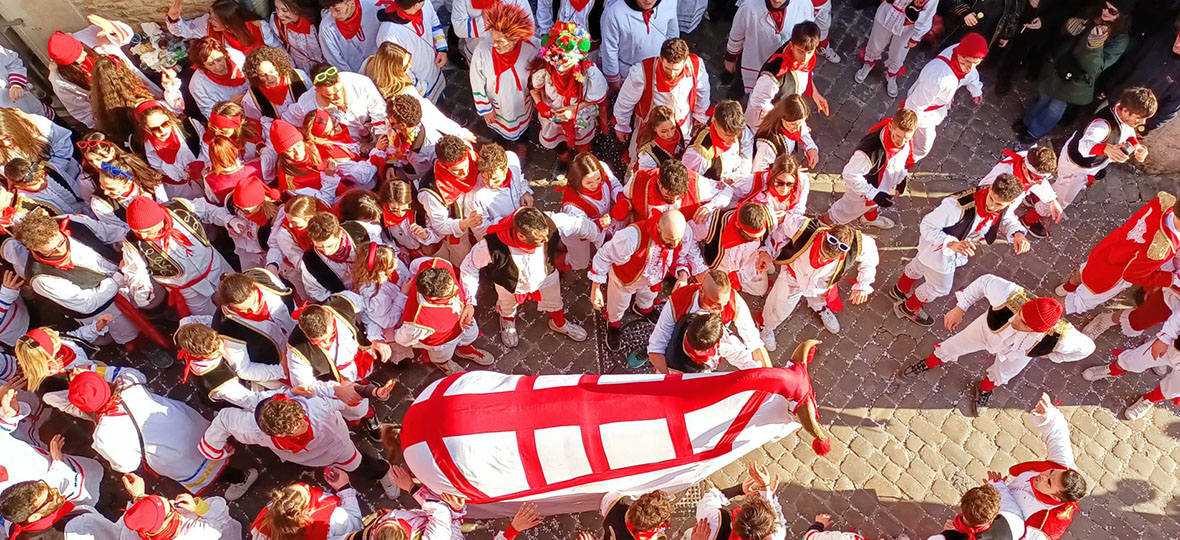“What in God’s name are you wearing?” my neighbour asks. “Me! Look at you! You look a right idiot.” So, there we stand in our respective costumes, surveying our splendour in my hallway mirror. Serena is costumed up as Po, the red Teletubby (UK kids TV show) and I’m Kermit the Frog. “We could become a thing,” I said. “It might catch on.”
February is Carnival month in Italy – when every city becomes a colourful sea of masks, confetti, and lights. It’s a celebration of ancient origins that has become a country-wide cultural event, combining tradition and fun, and creating unique shows.
Offida (province of Ascoli Piceno) is one of Italy’s top 20 most beautiful destination villages, and once a year becomes a cult destination for Carnival lovers. The reason for this is because of the inclusive atmosphere, the myths and ancient rituals, but above all, it’s the adrenaline-charged desire to have fun. It’s impossible to feel like a tourist.
2024 marks Offida’s 500th Carnival Anniversary. Historically speaking, these guys know how to throw a party.
One of the highlights of the Offida Carnival tradition is the symbolic bullfight (Lu Bov Fint, meaning fake bull) on Feb. 9. It dates to religious feasts of the ancient past, celebrating the New Year and the beginning of spring.
The fake bull is an oblong wood and iron frame covered with white and red cloth, adorned with an angry looking bovine head complete with a massive set of horns. The bull is carried on the shoulders of young men who run through the streets of Offida’s historic town centre, with chasing crowds coming up the rear, and other spectators hanging out of their windows cheering on the masses.

From under the frame, two very fit men blindly run the bull, while another two guide it from the outside. This is a much-lauded role and has men apply for the honorary position years in advance. Leading up to the day, the runners train hard for the task ahead. In fact, it’s so taxing on the mind, body, and senses, there are several back-up teams to take over and give the lead runners some respite.
From the top of the hill, and through Offida’s cobbled streets and narrow alleys, you can hear the echoing chants of the crowd. Thousands of people participate in this event (wearing the guazzarò or the typical bullfighter costume) chasing after the panicked bull, taunting it, poking at it, and shoving it along in the direction of Piazza del Popolo. The chaos caused by the bull’s sudden changes in direction, and the screams of the crowd generate moments of panic, which are generally resolved with hilarity and red wine, which is consumed in copious amounts.
Once on the Piazza, the crowd disperse, creating a clearing for the lengthy and dramatic bullfight. This is also the location of the bull’s demise, and before its symbolic slaughter, its horns are made to touch a column of the Town Hall. The final act of this celebration is a procession carrying the dead bull through the streets of Offida as the crowd sings what has now become the Carnival anthem. “Addio Ninetta Addio.”
Let’s burn them reeds
Meanwhile, on Shrove Tuesday (Feb. 13) it’s the turn of the ‘Vlurd’ procession. A dusk parade of ‘farmers’ clad in white robes, who slowly parade, in single file, through the streets of Offida, bearing massive burning spindles of tall reeds. As night descends the long procession of burning reeds take on the look of a flaming red serpent. Later, much later, several hundred farmers deposit their blazing bundles into the centre of Piazza del Popolo, which creates an enormous bonfire, symbolizing the start of Lent and the end of the Carnival. Screams and songs fuse with swirls of grey smoke and plumes of brilliant gold sparks as the pagan fire lights up the square.
For everyone, the traditional costume is the guazzarò – a white cloth garment edged in red (the colours of Carnival). It’s a close relation of the tunic that men and women once wore whilst working in the fields. It was also originally adopted during the traditional procession of li vlurd, so as not to get dirty while carrying the burning and partly charred bundles on their arms. Over time this garment has been reworked and has become the traditional uniform of carnival celebrations. But on this final day of the Carnival anything goes as everyone in Offida tries to out-dress and out-crazy the next with masks, wigs, painted faces, and bizarre costumes – most worn simultaneously.
 Then there’s the great masquerade ‘Veglionissimi’ after-party at the Serpente Aureo Theatre.
Then there’s the great masquerade ‘Veglionissimi’ after-party at the Serpente Aureo Theatre.
But around these events, whose origins are connected to 16th century peasants, there is much more. Costumed balls in the red velvet setting of the Serpente Aureo theatre, masked parades, food, and wine banquets and, most of all, the long preparation period that begins on Jan. 13, and following exacting events that demands perfect timing which all relies on the extraordinary organizational machine of the covens – historical masked groups, linked by kinship, and formed to embolden and bond traditions.
Each coven has its own organization, a uniform, a banner, and a distinctive form of participation in the Carnival. They are the true leaders of the carnival festivities, the creative people who tirelessly produce music, dancing, and other types of entertainment in the squares and at traditional gatherings. The real celebration begins when, on Shrove Tuesday the mayor of the Marche village hands them the key to the city.
The Offida Carnival is not a party to be attended, but a collective and somewhat frenzied ritual in which everyone, Offidans and visitors alike, must partake. It is an authentic interpretation of the free and inclusive spirit of the Carnival which, for just a few days, forgets formalities and divisions.
However, it may take some time for the good folk of Offida to forget about the antics of Kermit the Frog and his sidekick, Po, the red Teletubby.

